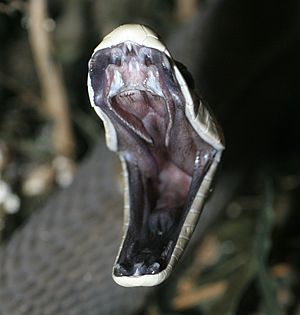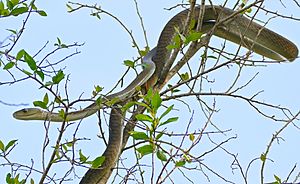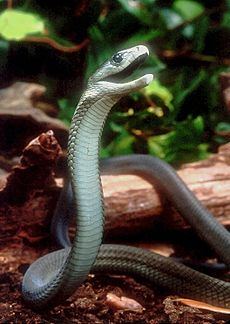Black mamba facts for kids
Quick facts for kids Black mamba |
|
|---|---|
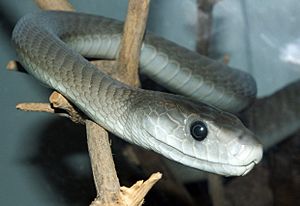 |
|
| Conservation status | |
| Scientific classification | |
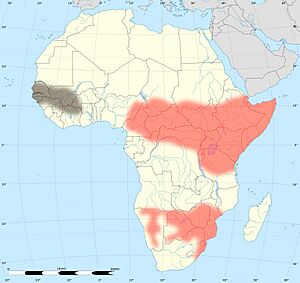 |
|
| Distribution range of black mamba in red (grey areas are inconclusive) | |
| Synonyms | |
|
List
Dendroaspis polylepis polylepis
(Günther, 1864) Dendraspis polylepis (Günther, 1864) Dendraspis angusticeps (Boulenger, 1896) Dendraspis antinorii (Peters, 1873) Dendroaspis polylepis antinorii (Peters, 1873) |
The black mamba (Dendroaspis polylepis) is a highly venomous snake. It is the second-longest venomous snake after the king cobra. Its venom is frequently fatal unless antivenom is administered. Despite its reputation, black mambas are primarily defensive animals. They will only bite if they feel threatened or cornered.
The species is native to parts of sub-Saharan Africa. It is rated as least concern on the International Union for Conservation of Nature (IUCN)'s Red List of Threatened Species.
Contents
Description
The black mamba isn't actually black. Baby mambas are often brownish-gray, gradually darkening to a grayish-brown or olive-brown as they grow. Their name comes from the dark, almost black color of the inside of their mouth, which they show when threatened.
These snakes are incredibly long and slender. Adults can grow to be anywhere from 6.5 to 14 feet (2 to 4.3 meters) long. They're very graceful and have smooth scales that shimmer in the sunlight. Their eyes are big and round, ranging between greyish-brown and shades of black.
The body mass of black mambas is around 1.6 kg (3.5 lb).
Habitat
Black mambas are found in sub-Saharan Africa. They prefer warm, dry habitats, like savannas, grasslands, rocky hillsides, and sometimes even woodlands. They are excellent climbers and can often be found in trees, but they spend a lot of time on the ground, too.
Behavior
Although they have a fearsome reputation, black mambas are actually quite shy and secretive creatures. They prefer to avoid humans and other potential threats. They are very fast and can move with incredible speed – up to 12 miles (19 kilometers) per hour. They can also rear up to a considerable height when threatened, displaying their impressive size and dark mouth. This is their way of warning potential attackers to stay away.
During the threat display, any sudden movement by the intruder may provoke the snake into performing a series of rapid strikes, leading to severe envenomation.
Reproduction and lifespan
Black mambas reproduce by laying eggs. A female mamba will lay a clutch of 6 to 25 eggs, usually in a sheltered location like a rock crevice or a termite mound. The eggs take about 2-3 months to hatch. The baby mambas are born already equipped with their deadly venom. The mother mamba does not care for her young; the baby mambas are completely independent from birth.
The black mamba is recorded to live up to 11 years and may live longer.
Diet
Black mambas are carnivores, which means they eat meat. Their diet mainly consists of other animals, mostly other smaller snakes, lizards, rodents (like mice and rats), and even birds. They are incredibly fast and agile hunters. They use their speed and agility to ambush their prey, striking quickly and precisely. Then, they use their powerful venom to subdue their meal.
Predators
Adult mambas have few natural predators aside from birds of prey, such as Brown snake eagles, tawny eagles and martial eagles, southern ground hornbills, marsh owls and hooded vultures. Young snakes have been recorded as prey of the Cape file snake. Black mambas have also been found amongst the stomach contents of Nile crocodiles.
Venom
The black mamba is the most feared snake in Africa because of its size, aggression, and venom toxicity. The bite of a black mamba can cause collapse in humans within 45 minutes. Without appropriate antivenom treatment, symptoms typically progress to respiratory failure, which leads to cardiovascular collapse and death. This typically occurs in 7 to 15 hours.
Unlike many venomous snake species, black mamba venom does not contain protease enzymes. Its bites do not generally cause local swelling or necrosis, and the only initial symptom may be a tingling sensation in the area of the bite. The snake tends to bite repeatedly and let go, so there can be multiple puncture wounds. Its bite can deliver about 100–120 mg of venom on average; the maximum recorded dose is 400 mg. Bites were often fatal before antivenom was widely available.
Treatment
Standard first aid treatment for any suspected bite from a venomous snake is the application of a pressure bandage to the bite site, minimisation of movement of the victim and conveyance to a hospital or clinic as quickly as possible. The neurotoxic nature of black mamba venom means an arterial tourniquet may be of benefit. Tetanus toxoid is sometimes administered, though the main treatment is the administration of the appropriate antivenom. A polyvalent antivenom produced by the South African Institute for Medical Research is used to treat black mamba bites, and a new antivenom was being developed by the Universidad de Costa Rica's Instituto Clodomiro Picado.
Interesting facts about black mambas
- They can move at speeds up to 12 mph (19 km/h).
- Adults can reach up to 14 feet (4.3 meters) long.
- Their venom is a potent neurotoxin.
- Black mambas have excellent vision.
- Their digestive system can fully digest prey in eight to ten hours.
- The black mamba can launch as much as 40% of its body length upwards, so mamba bites to humans can occur on the upper body.
See also
 In Spanish: Mamba negra para niños
In Spanish: Mamba negra para niños



